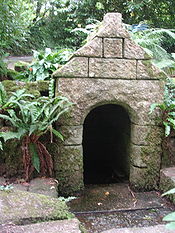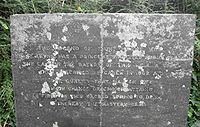
Saint Keyne
Encyclopedia

West Country
The West Country is an informal term for the area of south western England roughly corresponding to the modern South West England government region. It is often defined to encompass the historic counties of Cornwall, Devon, Dorset and Somerset and the City of Bristol, while the counties of...
, between Liskeard and Looe in SE Cornwall. She is not mentioned as being a saint in the official Catholic encyclopaedia - newadvent.org, so perhaps it's disputable if she is indeed a Catholic saint. The works she is reputed to have done are quite unsaintly, so it is probable that this page is not accurate.
Keyne was a pious virgin, one of the many daughters of King Brychan
Brychan
Brychan Brycheiniog was a legendary 5th-century king of Brycheiniog in South Wales.-Life:Celtic hagiography tells us that Brychan was born in Ireland, the son of a Prince Anlach, son of Coronac, and his wife, Marchel, heiress of the Welsh kingdom of Garthmadrun , which the couple later inherited...
of Brycheiniog
Brycheiniog
Brycheiniog was a small independent petty kingdom in South Wales in the Early Middle Ages. It often acted as a buffer state between England to the east and the powerful south Welsh kingdom of Deheubarth to the west. It was conquered and pacified by the Normans between 1088 and 1095, though it...
(Brecon). She may havelived at Keynsham
Keynsham
Keynsham is a town and civil parish between Bristol and Bath in Somerset, south-west England. It has a population of 15,533.It was listed in the Domesday Book as Cainesham, which is believed to mean the home of Saint Keyne....
in Somerset
Somerset
The ceremonial and non-metropolitan county of Somerset in South West England borders Bristol and Gloucestershire to the north, Wiltshire to the east, Dorset to the south-east, and Devon to the south-west. It is partly bounded to the north and west by the Bristol Channel and the estuary of the...
but founded St Keyne
St Keyne
St Keyne is a civil parish and village in Cornwall, United Kingdom. The parish lies between the parishes of Liskeard and Duloe.In Victorian times the holywell in St Keyne had the reputation of conferring supremacy to the marriage partner who first tasted it.The church is dedicated to Saint Keyne...
in Cornwall
Cornwall
Cornwall is a unitary authority and ceremonial county of England, within the United Kingdom. It is bordered to the north and west by the Celtic Sea, to the south by the English Channel, and to the east by the county of Devon, over the River Tamar. Cornwall has a population of , and covers an area of...
, (among other sites) in the late 5th century, and left her name to a church and to a well, the latter whose waters are said to give the upper hand to whichever of two newly-weds first drinks of them. In 490 she visited her brother Saint Cadoc at St Michael's Mount, where a granite chair (throne?) supposedly is said to grant matrimonial advantage.
She died a virgin on 5 October in either 490 or 505, more likely the later, she ... "grew up to be very beautiful, and many young men sought her hand in marriage, but she rejected them all." Her feast day is also recorded as 30 September. The Celtic harvest festival was driven more by sun and moon than by an otherwise proscribed calendar.
She was the original patron of what is now St Martin's-by-Looe and is linked with Kenwyn in Truro. She is known to have founded a few churches: Llangeinor in mid Glamorgan, Llangunnor and Llangain in Dyfed, at Rockfield (Llangennon) an Runston, in Gwent. ['Llan', in Celtic, means 'Holy Place (of...)'] She is also recorded as being a dragon-slayer, on par with St George.

Her feast is celebrated on 8 October.
Further reading
- A Pilgrims Guide to the Holy Wells of Cornwall, J Meyrick. pp 68–69
- A Guide to the Saints of Wales and the Westcountry, Ray Spencer. pp51–52
- The Saints of Cornwall, Catherine Rachel John. pp 42–43
- Oxford English Dictionary of Saints, David High Farmer

